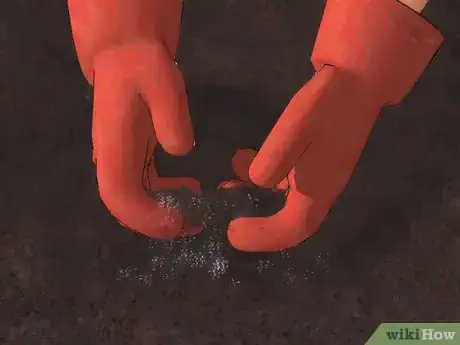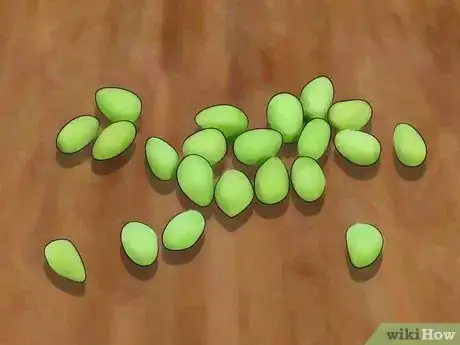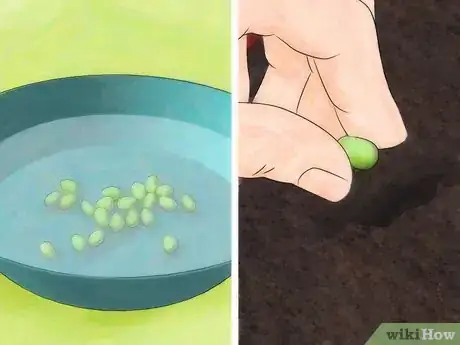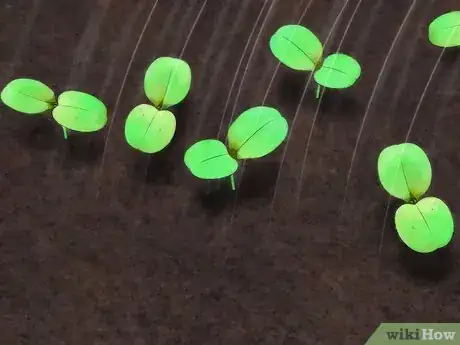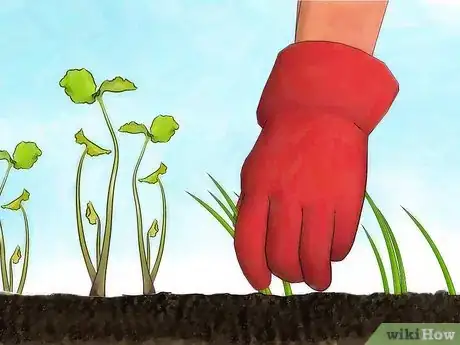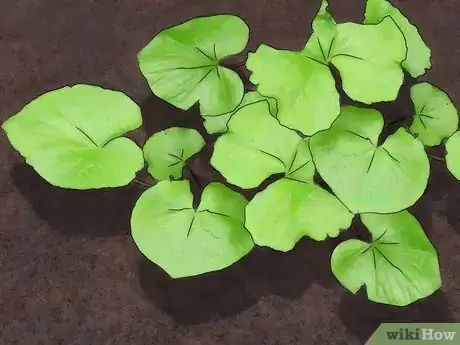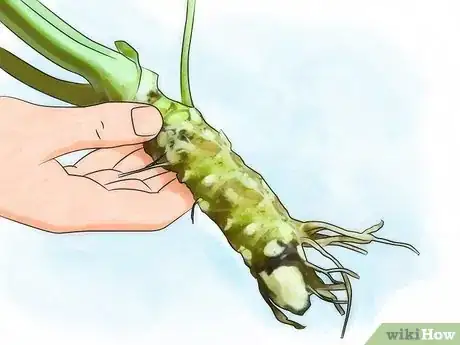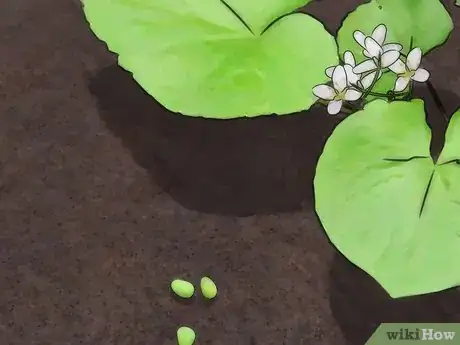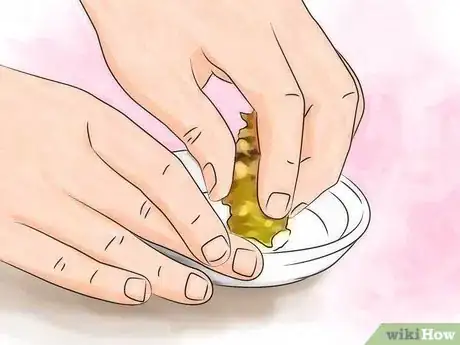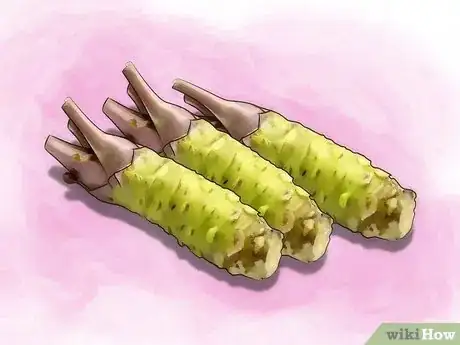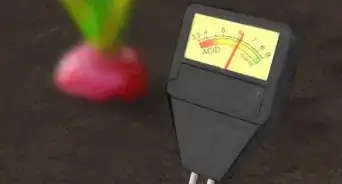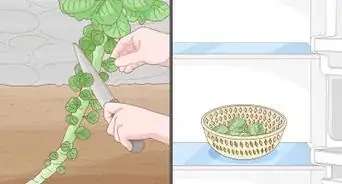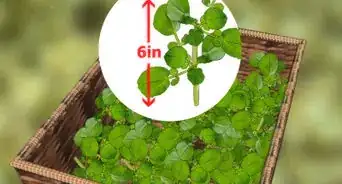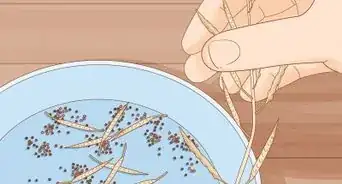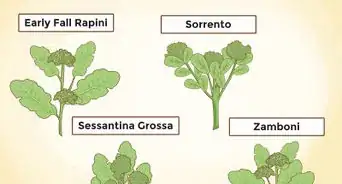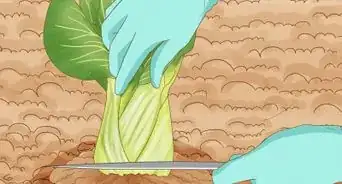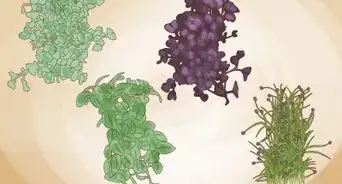This article was co-authored by Andrew Carberry, MPH. Andrew Carberry is a Food Systems Expert and the Senior Program Associate at the Wallace Centere at Winrock International in Little Rock, Arkansas. He has worked in food systems since 2008 and has experience working on farm-to-school projects, food safety programs, and working with local and state coalitions in Arkansas. He is a graduate of the College of William and Mary and holds a Masters degree in public health and nutrition from the University of Tennessee.
wikiHow marks an article as reader-approved once it receives enough positive feedback. This article received 11 testimonials and 96% of readers who voted found it helpful, earning it our reader-approved status.
This article has been viewed 407,310 times.
Wasabi is widely considered to be one of the most difficult plants to grow. It requires a humid, temperate environment, takes two years to mature, and is highly susceptible to disease when grown in large quantities. The reward of growing wasabi outweighs the difficulty, since it has numerous health benefits and a distinctive fresh, hot, sweet flavor that can't be matched. If you're up for a challenge, growing wasabi is possible when you replicate the wild conditions in which wasabi grows best.
Steps
Creating the Right Conditions
-
1Locate an environment that's humid and temperate. Wasabi is native to Japan, and grows best in a wet, warm climate between 45 °F (7 °C) and 70 °F (21 °C). Wasabi is notoriously finicky and will not grow in places where the temperature routinely rises or falls out of this small range.
- Wasabi naturally grows in wet, wooded areas with plenty of moisture in the air and well-draining soil.
- In the USA, parts of the Pacific Northwest and the Blue Ridge Mountains have the right conditions for growing wasabi. Few other places are naturally suitable for growing the plant.
-
2Consider temperature control solutions. If you live in a region that doesn't have the natural climate necessary for growing wasabi, you will need to recreate the right conditions manually. One of the best ways to do so is by using a greenhouse, which traps heat and humidity and allows you to control the temperature. If you decide to use a greenhouse, adjust the settings so that the temperature is always between 45 and 70 degrees Fahrenheit.
- If you live in a place where the growing conditions are fairly close to what wasabi naturally needs, you may be able to get away without using a greenhouse. If you live in a hot region, use a tarp or sheet to shade the planting bed so it won't get too hot. If you live in a place with mild cold snaps, cover the plants when the temperature gets cold.
Advertisement -
3Pick a well-shaded spot. Wasabi does not do well in direct sunlight; it needs a very shady spot. In the wild, wasabi grows under forest canopy, where just enough sunlight filters through the leaves to give the wasabi what it needs to flourish. As a home cultivator, try to replicate this environment either by planting the wasabi under trees or using a hand-fashioned canopy to shade the growing bed.
- In a greenhouse, it's still important to make sure the wasabi gets plenty of shade. Situate the wasabi under taller plants or near shaded windows to make sure it isn't struck by direct sunlight.
-
4Amend the soil. Use a mixture of compost and organic, sulfur-rich fertilizer. Till the soil to a depth of 10 inches (25.4 cm) and work in ten inches of compost to create a rich, healthy soil. Test and adjust soil pH until it falls between 6 and 7. This specific pH creates the best environment for wasabi. You want a very rich, organic soil with just the right pH to give your wasabi the best chance of surviving in a home setting.[1]
- Follow label instructions when applying fertilizer.
-
5Make sure the soil drains well. Wasabi likes to be kept moist, but not muddy and waterlogged. To check whether the soil drains well enough, water the area well and watch the water soak in. If it's slow to be absorbed, work in more compost. If it drains right away, the soil is fine for wasabi.
- Planting wasabi near a natural pond or stream is a good idea, since the soil will stay constantly moist, but will naturally also drain well.
- You could also plant wasabi near a waterfall that will continuously splash on the plant to provide water.
Planting and Caring for Wasabi
-
1Order seeds in late fall. Wasabi seeds are difficult to source at local nurseries, so most people order them online. Late fall is the best time to order seeds; wasabi needs the winter to establish good roots. When the seeds arrive, keep them moist and plan to plant within 48 hours of receipt.[2]
-
2Plant the seeds. The night before you plant them, place the seeds in a small bowl and cover them with distilled water. Soak the seeds overnight prior to planting. Soaking will help to soften the seed shells and make it easier for the wasabi to germinate. Sow the seeds one to two inches apart and press them lightly into the soil.
-
3Keep the soil and seedlings moist. Wasabi is a semi-aquatic plant that must be kept wet to flourish. Every day, mist the soil and the sprouting seedlings with fresh, cool water to emulate splashes from natural water sources, like a stream or waterfall. If the wasabi is allowed to dry out, it will begin to wilt.
- A micro-irrigation system is a good alternative to misting. Watch your plants for wilting (not enough water) and root rot (too much water), and adjust your irrigation accordingly.
- Because wasabi must be kept wet, it is susceptible to mold and disease. If you see a plant become diseased (wilted and discolored), pull it out right away to prevent it from spreading to other plants. Do not soak the soil or plants with a hose or watering can, as this increases the chance of rot and disease.
-
4Weed the planting beds. Weed out competing plants so the wasabi roots have plenty of room to grow. Since the soil is kept moist on a daily basis, weeds tend to sprout quickly. Weeding every day or every other day will keep the problem under control.
Harvesting and Using Wasabi
-
1Care for the plants for two years before harvest. Wasabi doesn't develop its distinctive flavor until it becomes mature after about 24 months. During this time the wasabi will grow about two feet tall and two feet wide. It will stop getting taller and wider, and start putting energy into growing a long, carrot-like rhizome beneath the soil.
-
2Dig the mature rhizomes. Rhizomes are mature and ready to eat when they're about seven or eight inches long. Dig up one rhizome to check the length before completing the rest of the harvest. Use a long, slim spade or pitchfork and take care not to cut the rhizomes when you dig it out.
-
3Leave some plants in the ground to self-seed. Wasabi left in the ground will produce new seeds and drop them into the soil, saving you the trouble of ordering more seeds. Leave several plants in the ground so you'll have a fresh crop of wasabi in the next couple of years.
- When the new plants begin to sprout, space the seedlings about 12 inches (30 cm) apart so they have plenty of room to grow. If you leave them in clumps, many will wilt and die.
-
4Use the wasabi. Clean the wasabi rhizomes and discard the leaves. To enjoy wasabi's fresh, sharp flavor, shave off as much as you need and leave the rest of the rhizome intact. The heat of the wasabi will fade after a few hours, so it's best to cut off only as much as you need for one meal at a time.
-
5Store wasabi for later use. Fresh wasabi will keep in the refrigerator for about a month or two before it begins to rot. If you want to save wasabi for later use, it's best to dry it out and grind it into a powder. The powder can be mixed with a little water to form wasabi paste.
Expert Q&A
Did you know you can get expert answers for this article?
Unlock expert answers by supporting wikiHow
-
QuestionHow long does it take for seeds to germinate?
 Andrew Carberry, MPHAndrew Carberry is a Food Systems Expert and the Senior Program Associate at the Wallace Centere at Winrock International in Little Rock, Arkansas. He has worked in food systems since 2008 and has experience working on farm-to-school projects, food safety programs, and working with local and state coalitions in Arkansas. He is a graduate of the College of William and Mary and holds a Masters degree in public health and nutrition from the University of Tennessee.
Andrew Carberry, MPHAndrew Carberry is a Food Systems Expert and the Senior Program Associate at the Wallace Centere at Winrock International in Little Rock, Arkansas. He has worked in food systems since 2008 and has experience working on farm-to-school projects, food safety programs, and working with local and state coalitions in Arkansas. He is a graduate of the College of William and Mary and holds a Masters degree in public health and nutrition from the University of Tennessee.
Food Systems Expert
-
QuestionCan wasabi be grown hydroponically?
 Andrew Carberry, MPHAndrew Carberry is a Food Systems Expert and the Senior Program Associate at the Wallace Centere at Winrock International in Little Rock, Arkansas. He has worked in food systems since 2008 and has experience working on farm-to-school projects, food safety programs, and working with local and state coalitions in Arkansas. He is a graduate of the College of William and Mary and holds a Masters degree in public health and nutrition from the University of Tennessee.
Andrew Carberry, MPHAndrew Carberry is a Food Systems Expert and the Senior Program Associate at the Wallace Centere at Winrock International in Little Rock, Arkansas. He has worked in food systems since 2008 and has experience working on farm-to-school projects, food safety programs, and working with local and state coalitions in Arkansas. He is a graduate of the College of William and Mary and holds a Masters degree in public health and nutrition from the University of Tennessee.
Food Systems Expert
-
QuestionCan wasabi be grown in a pot?
 Community AnswerYes. I'm growing wasabi in a 10 inch pot on my balcony without trouble. It's important to keep it fairly shaded and protected from frost and pests. And remember to add fertilizer every now and then.
Community AnswerYes. I'm growing wasabi in a 10 inch pot on my balcony without trouble. It's important to keep it fairly shaded and protected from frost and pests. And remember to add fertilizer every now and then.
Warnings
- Black rot can threaten wasabi plants; take care not to leave the plants sitting in waterlogged soil.⧼thumbs_response⧽
- Aphids like wasabi. Treat with an aphid spray.⧼thumbs_response⧽
- Cats can be attracted to wasabi leaves.⧼thumbs_response⧽
- Wasabi is prone to slugs, especially in the early growing stages. Deter and remove them.⧼thumbs_response⧽
- Wasabi leaves and leaf stems (petioles) are brittle. Any breaks or disturbances can slow and stop growth.⧼thumbs_response⧽
References
About This Article
To grow wasabi, select a shady spot that is humid and temperate all year long. A temperature-controlled location like a greenhouse is ideal. Next, soak the wasabi seeds overnight in distilled water, then sow them in well-draining soil about 1-2 inches apart. Mist the soil and seedlings every day with fresh, cool water to keep the environment moist. Keep the area clear of weeds and allow 24 months for the wasabi to mature before harvesting it! For tips on harvesting your mature wasabi plants, read on!



